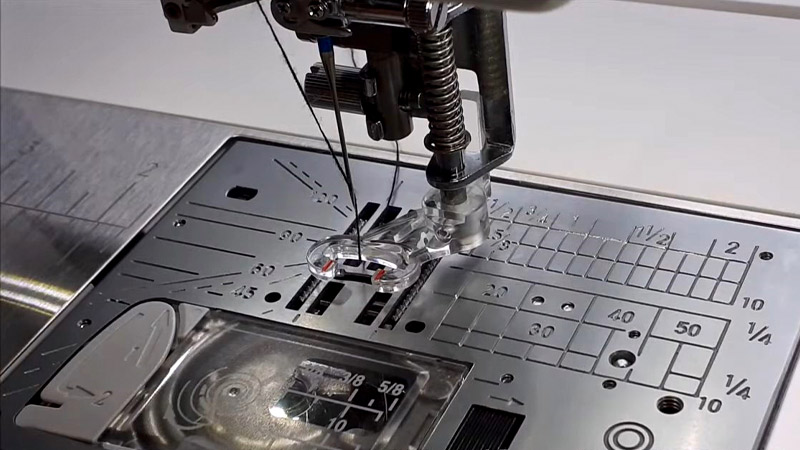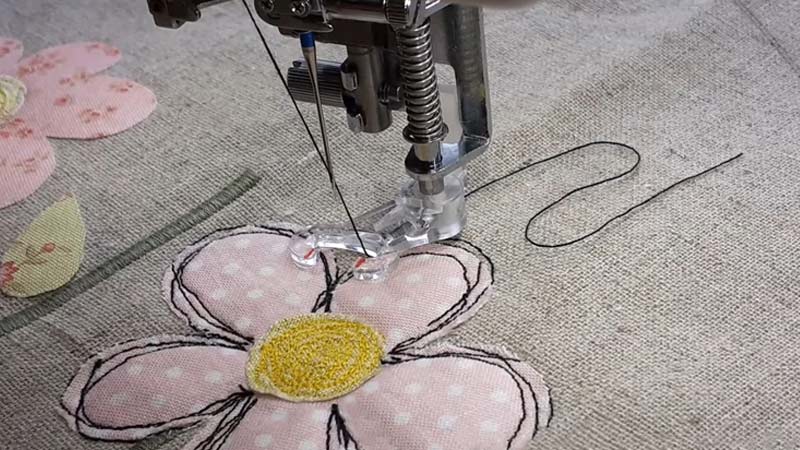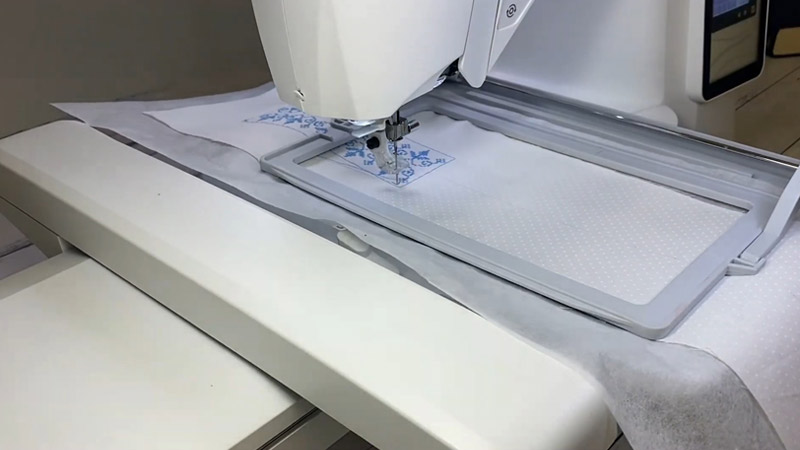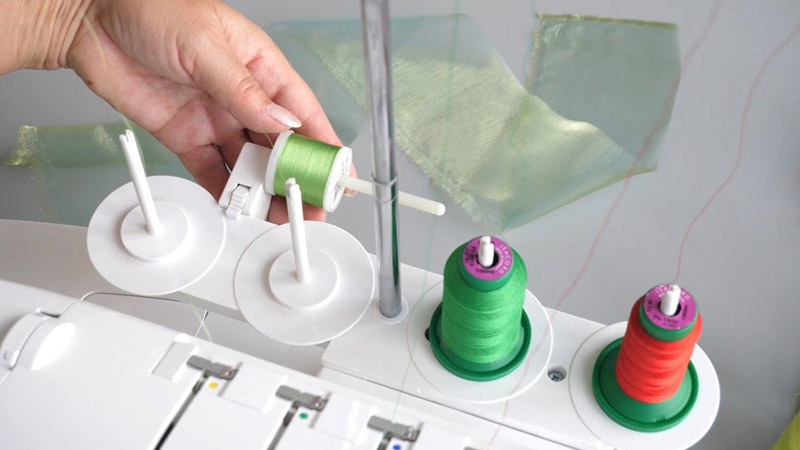In the intricate sewing world, presser feet are pivotal in achieving precision and creativity. The Embroidery Foot and Free Motion Foot stand out for their distinct purposes among the array of options.
While both are essential for embellishing fabrics and adding artistic flair to projects, understanding whether they are interchangeable remains a common query for sewing enthusiasts. So, is an embroidery foot the same as a motion foot? When do you use them?
In this exploration, we delve into the nuances of these specialized presser feet, unraveling the similarities and differences that define their functionalities.
Whether you’re a seasoned seamstress or a novice needleworker, join us on this journey to decipher if an Embroidery Foot is indeed synonymous with a Free Motion Foot, unlocking the secrets behind each stitch and unraveling the threads that connect these essential tools in the sewing realm.

Is an Embroidery Foot the Same as a Free Motion Foot?
The Embroidery and Free Motion Foot are two distinct presser feet in the sewing world, each serving specific purposes. While they share some similarities, they are not entirely interchangeable.
To understand their differences, let’s delve into the characteristics and functionalities of each.
Embroidery Foot
The Embroidery Foot is a specialized presser foot designed for intricate and decorative stitching. Its key feature is a wide open-toe design, allowing for better visibility of the needle and the area where stitches are being placed.
This visibility is crucial when working on detailed embroidery projects, ensuring precision and accuracy.
Embroidery Foot Function
One of the embroidery feet’ primary functions is accommodating the embroidery hoop’s movement. This foot is engineered to glide smoothly over the fabric while the needle creates intricate patterns. It provides stability and control, making it easier for the sewer to follow complex designs.
The Embroidery Foot also often comes with a spring-loaded mechanism. This feature allows the foot to move up and down with the needle, preventing the foot from hindering the fabric’s movement.
This is especially beneficial when working on densely embroidered areas or when navigating tight curves.
Free Motion Foot

On the other hand, the Free Motion Foot, also known as a darning foot, is designed for artistic free-motion stitching. This foot differs significantly from the Embroidery Foot in terms of its construction and purpose.
Unlike the Embroidery Foot, the Free Motion Foot has a completely closed toe, creating a small, confined space for the needle.
Free Motion Foot Function
The closed-toe design of the Free Motion Embroidery Foot provides stability and support when the sewer is in control of the stitch length and direction.
This is particularly useful when working on quilting projects or any application with desired free-form stitching.
The confined space around the needle prevents the fabric from shifting excessively, allowing the sewer to create intricate patterns and designs.
The Free Motion Foot is characterized by its spring-loaded mechanism as well. This mechanism allows the foot to bounce slightly as the fabric is moved manually beneath the needle.
This bouncing action enables the sewer to control the stitch length by adjusting the speed and movement of the fabric. This freedom of movement gives the Free Motion Foot its name.
Can They Be Used Interchangeably?

While there might be situations where you can use one foot for a task typically associated with the other, it’s important to understand that their designs and functionalities cater to specific needs.
Using an Embroidery Foot for free-motion stitching may limit visibility, control, and flexibility. Similarly, employing a Free Motion Foot for detailed embroidery might compromise precision.
Key Differences
Let’s unravel the threads that distinguish these two essential tools, exploring their toe designs, movement mechanisms, and overarching purposes.
Toe Design
Boasting an open-toe design, the Embroidery Foot prioritizes visibility, making it an ideal companion for intricate embroidery work where precision is paramount.
Featuring a closed toe, the Free Motion Foot provides a confined space around the needle, offering stability and control crucial for free-motion stitching adventures.
Movement Mechanism
Often equipped with a spring-loaded mechanism, the free-sewing foot harmonizes with the movement of the embroidery hoop, ensuring seamless navigation over fabric surfaces.
Similarly adorned with a spring-loaded mechanism, the Free Motion Foot takes on a different role—allowing controlled bouncing. This bouncing action facilitates fabric manipulation beneath the needle during artistic free-motion stitching.
Purpose
Tailored specifically for embroidery projects, the Embroidery Foot thrives in scenarios where meticulous precision and enhanced visibility are non-negotiable.
Embraced for its versatility, the Free Motion Foot finds its calling in the realm of artistic expression, particularly in quilting and other creative applications demanding free-form stitching.
Stitch Control
It offers more controlled and predictable stitch patterns, making it suitable for precisely replicating intricate designs.
Provides the freedom for the sewer to manually control stitch length and direction, allowing for unique, artistic stitches and designs.
Fabric Movement
Facilitates smooth movement over the fabric, which is particularly beneficial when following detailed embroidery patterns or navigating tight curves.
Enables the sewer to manually move the fabric in any direction, empowering the creation of complex and personalized stitching patterns.
What Are Some Other Embroidery Attachments for Singer Sewing Machines?
Singer sewing machines are renowned for their versatility, and enthusiasts often seek additional attachments to enhance their embroidery capabilities.
Here’s a comprehensive exploration of various embroidery attachments compatible with Singer sewing machines:
Embroidery Hoops

Essential for securing the fabric in place during embroidery, these hoops come in various sizes to accommodate different projects. The screw-type hoop is a common choice, providing easy and secure fabric tensioning.
Embroidery Needles
Specialized needles designed for embroidery work can make a significant difference. Needles with a larger eye help accommodate embroidery threads, reducing the risk of breakage or fraying.
Embroidery Presser Foot
Beyond the standard presser feet, Singer offers specialized embroidery presser feet. The Embroidery Foot, often included with embroidery-capable machines, allows for precise stitching and visibility. Additionally, a Monogramming Foot is handy for creating intricate monograms.
Embroidery Attachment Sets
Some Singer models have dedicated embroidery attachment sets. These sets may include a range of presser feet, hoops, and other accessories to expand the machine’s embroidery capabilities.
Thread Stand
An external thread stand can be beneficial when working with multiple thread colors. It provides smooth thread delivery, reducing the likelihood of thread tangling or breaking during embroidery.
Thread Spool Caps

Thread spool caps help control thread tension and prevent tangling. They are particularly useful when working with specialty threads that may be more delicate or prone to knotting.
Embroidery Software
Singer-compatible embroidery software opens up a world of design possibilities. Users can create, edit, and customize embroidery designs on their computer before transferring them to the sewing machine. This software often supports various file formats, including popular ones like .pes and .dst.
Stabilizers
Stabilizers play a crucial role in embroidery by supporting the fabric and preventing puckering or stretching. Singer offers tear-away, cut-away, and wash-away stabilizers suitable for different fabrics and projects.
Embroidery Attachment Kits
Comprehensive embroidery attachment kits may include various accessories such as presser feet, needles, and thread. These kits are curated to meet the diverse needs of embroidery enthusiasts and often come in a convenient storage case.
Embroidery Bobbins
While standard bobbins can be used, having dedicated embroidery bobbins ensures consistent tension and thread compatibility. These bobbins often come in pre-wound packs, saving time and effort.
Quilting Foot
While primarily designed for quilting, a walking or even-feed quilting foot can benefit embroidery. It ensures even fabric feeding, reducing the chances of puckering or misalignment during intricate embroidery projects.
Circular Embroidery Attachment
Ideal for creating circular and radial designs, this attachment allows for precise stitching in concentric circles. It’s a versatile tool for embellishing projects with decorative patterns.
Cording Foot
The cording foot incorporates cords or decorative threads into embroidery designs. It guides the cord smoothly, adding texture and dimension to the stitched patterns.
Singer Futura AutoPunch Software
For those with Singer Futura embroidery machines, the AutoPunch software is a valuable addition. It converts images into embroidery designs, offering creative freedom to personalize projects with unique artwork.
Open Toe Embroidery Foot
The open-toe embroidery foot for sewing machines is a specialized presser foot designed for sewing machines, including Singer models, that allows for greater visibility during embroidery work.
The defining feature of the open-toe embroidery foot is its clear, open front. This design provides maximum visibility of the needle and the stitching area.
Sewers can easily monitor the placement of stitches, making it ideal for intricate embroidery and decorative stitching.
FAQs
What is the difference between darning and free motion feet for Singer sewing and embroidery machines?
The main difference lies in their design and purpose. A darning foot is typically used for repairing or reinforcing fabric, allowing you to darn holes or mend tears.
On the other hand, a free-motion foot is designed for creative stitching, particularly in quilting and embroidery, allowing you to move the fabric freely in any direction.
Can I use a darning foot for free motion embroidery on my Singer sewing machine?
While it’s possible to use a darning foot for some free-motion work, it may not provide the same level of control and stability as a dedicated free-motion foot.
The closed-toe design of a free-motion foot offers better support for artistic stitching, making it a preferred choice for intricate embroidery projects.
Are open-toe embroidery feet compatible with Singer sewing and embroidery machines?
Yes, many Singer sewing and embroidery machines support open-toe embroidery feet. These specialized presser feet with an open front enhance visibility during embroidery work, allowing for precise stitching.
Can I use any embroidery attachment with my Singer sewing and embroidery machine?
Not all embroidery attachments are universally compatible. It’s essential to check your Singer machine’s manual or contact the manufacturer to ensure compatibility with specific embroidery attachments.
Do Singer sewing and embroidery machines have built-in embroidery features, or do I need additional attachments?
Many modern Singer sewing machines have built-in embroidery features, especially those designed for embroidery. These machines often include a variety of built-in stitches, fonts, and even embroidery designs.
Conclusion
While the Embroidery Foot and Free Motion Foot share certain characteristics, they each bring unique attributes to the sewing table.
The Embroidery Foot excels in precision in intricate designs, ensuring meticulous detailing for delicate projects.
On the other hand, the Free Motion Foot offers the freedom to unleash your creativity, enabling freeform stitching and artistic expression.
Choosing between an Embroidery Foot and a Free Motion Foot ultimately hinges on your specific requirements.
Whether you’re embroidering intricate patterns or engaging in free-motion quilting, understanding the nuances of these presser feet empowers you to make informed decisions, elevating the quality and creativity of your craft.
So, as you thread your way through the stitches of your next project, consider the unique strengths of each foot, and let your sewing machine become the instrument through which your artistic vision seamlessly comes to life.
Leave a Reply